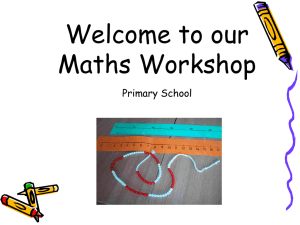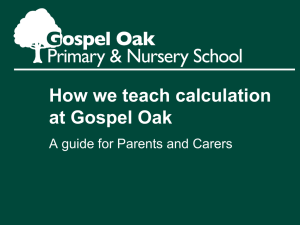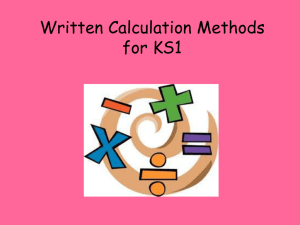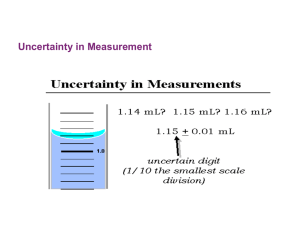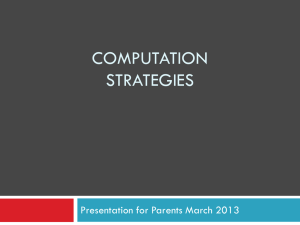Progression in Maths - Kirkburton CE First School
advertisement
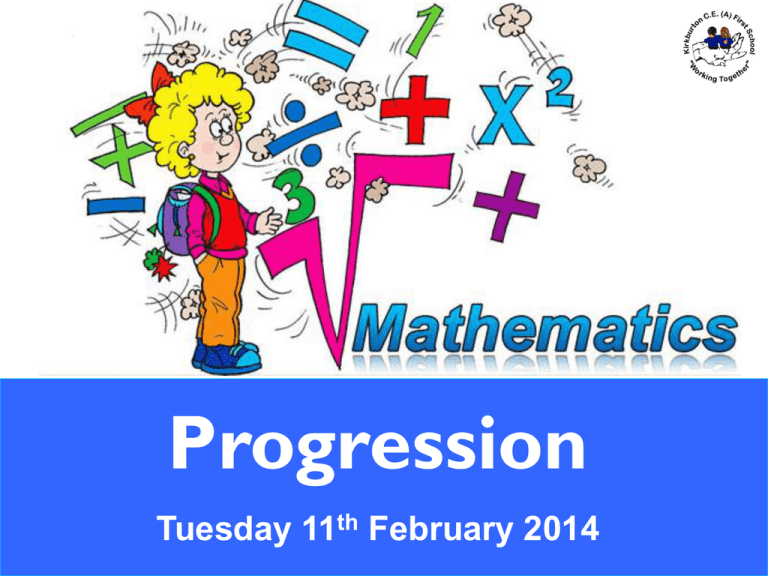
Progression Tuesday 11th February 2014 Counting Developing counting skills. Knowing the number names in order. Synchronising saying words and pointing or moving objects. Keeping track of objects counted. Recognising that the number associated with the last object touched is the total number of objects. Recognising small numbers of objects without counting them. Counting Developing counting skills.. continued counting things you cannot move or touch or see, or objects that move around. counting objects of different sizes. recognising that if a group of objects already counted is re-arranged then the number of them stays the same. recognising that if objects are added or removed the number changes. • This focuses on the development of children’s awareness, understanding and use of the language of number. Addition These are a selection of mental strategies: Mental recall of number bonds 6 + 4 = 10 + 3 = 10 25 + 75 = 100 19 + = 20 Use near doubles 6 + 7 = double 6 + 1 = 13 + MENTAL MATHS Addition using partitioning and recombining 34 + 45 = (30 + 40) + (4 + 5) = 79 Counting on or back in repeated steps of 1, 10, 100, 1000 86 + 57 = 143 (by counting on in tens and then in ones) 460 - 300 = 160 (by counting back in hundreds) Add the nearest multiple of 10, 100 and 1000 and adjust 24 + 19 = 24 + 20 – 1 = 43 458 + 71 = 458 + 70 + 1 = 529 Use the relationship between addition and subtraction 36 + 19 = 55 19 + 36 = 55 55 – 19 = 36 55 – 36 = 19 Addition Practical How can I record? Draw simple pictures and talk about it… Record ideas in a number sentence…. Addition Addition Addition Addition Reordering to start with the largest number. Number line Addition Number line Addition Addition Partitioning Addition These are introduced when the children have a sound grasp of place value & of the whole addition process. Addition Standard Method Column addition…. 364 + 54 418 1 £. 14.62 + 1.87 56.49 1 238.612 1051.05 + 81.069 1370.731 1 1 11 Subtraction - These are a selection of mental strategies: Mental recall of addition and subtraction facts 4 = 10 – 6 20 - 17 = 3 10 - □=2 □ - 8 = 11 Find a small difference by counting up 82 – 79 = 3 MENTAL MATHS Counting on or back in repeated steps of 1, 10, 100, 1000 86 - 52 = 34 (by counting back in tens and then in ones) 460 - 300 = 160 (by counting back in hundreds) Subtract the nearest multiple of 10, 100 and 1000 and adjust 24 - 19 = 24 - 20 + 1 = 5 458 - 71 = 458 - 70 - 1 = 387 Use the relationship between addition and subtraction 36 + 19 = 55 19 + 36 = 55 55 – 19 = 36 55 – 36 = 19 Subtraction 5 Subtraction Subtraction Number line Subtraction Subtraction Subtraction Subtraction Partitioning 74 – 27 74 – 20 = 54 54 – 7 = 47 27 = 20+7 Subtraction Subtraction Subtraction New Facts from known ones 3+4=7 Place Value Inverse 13+14 = 27 30+40=70 0.3+0.4 = 0.7 30+4=34 4+3=7 7-3=4 7-4=3 Near facts Equivalent 4+4=8 3+3=6 2+5=7 1+6= 7 Multiplication These are a selection of mental strategies: x Doubling and halving Applying the knowledge of doubles and halves to known facts. MENTAL Using multiplication facts Year 2 ~ 2x, 5x, 10x Year 3 ~ 2x, 3x, 4x, 5x, 6x, 8x, 10x Year 4 ~ Calculate all multiplication facts up to 12 x 12 Year 5 ~ Quickly recall all facts up to 12 x 12. MATHS Using and applying multiplication facts Use tables knowledge to derive other facts. e.g. If I know 3 x 7 = 21, what else do I know? 30 x 7 = 210, 300 x 7 = 2100, 3000 x 7 = 21 000, 0.3 x 7 = 2.1 etc Multiplying by 10 or 100 Knowing the effect of multiplying by 10 (shift in the digits one place to the left). Knowing the effect of multiplying by 100 (shift in the digits two places to the left). Partitioning 23 x 4 = (20 x 4) + (3 x 4) = 80 + 12 = 102 Use of factors 8 x 12 = 8 x 4 x 3 Multiplication Children are introduced to multiplication by counting on and back in equal steps of ones, twos, fives and tens. Working practically or drawing a picture helps children to visualise the problem. 4x2 Multiplication First recognize that multiplication is repeated addition. No of lots 3 how many per group x 5 total = 15 Is the same as 3 lots of 5 or 5 + 5 +5 = 15 Use pictorial cues to represent a x sum. Encourage them to write the sum: 5 + 5 + 5 = 15 Multiplication Children use arrays to model a multiplication calculation. 3x5 5x3 Using repeated addition 0 1 2 3 4 5 6 7 8 9 10 11 12 13 14 15 Multiplication Dots or tally marks are often drawn in groups. This shows 3 groups of 6. 3x6 Children can count on in equal steps using an empty number line. This shows 4 jumps of 4. Multiplication Multiplication Multiplication Grid method of multiplication 38 x 72 X 70 2 30 2100 60 8 560 16 2160 + 576 2736 1 Multiplication 1692 Multiplication Division These are a selection of mental strategies: Doubling and halving Knowing that halving is dividing by 2 and doubling is multiplying by 2 ÷ MENTAL Deriving and recalling division facts Recall corresponding division facts linked to tables knowledge. Know 5 x 6 = 30 so ? ÷ 5 = 6 MATHS Using and applying division facts Children should be able to utilise their tables knowledge to derive other facts. e.g. If I know 3 x 7 = 21, what else do I know? 21÷ 7 = 3, 21 ÷ 3 = 7, 3000 x 7 = 21 000, 0.3 x 7 = 2.1 etc Dividing by 10 or 100 Knowing the effect of dividing by 10 (shift in the digits one place to the right). Knowing the effect of dividing by 100 (shift in the digits two place to the right). Use related facts Given that 1.4 x 1.1 = 1.54 What is 1.54 ÷ 1.4, or 1.54 ÷ 1.1? Division Sharing is a skill children come to school with. ‘One for me one for you’ is repeated subtraction. Working practically or drawing a picture helps children to visualise the problem. 12 ÷ 2 = 6 Division Children progress to removing ‘groups’ of a number. There are 12 sweets and each party bag needs three sweets. How many party bags can be made? In this example children put ‘groups of three sweets’ into the party bags until they have no sweets left. Division Division Children can count on in equal steps using an empty number line to work out how many groups of there are. This shows you need 4 jumps of 7 to reach 28. Children begin to jump in ‘chunks’ of the number they are dividing by, in this example ‘chunks of 4’ are used. A jump of 10 groups of 4 takes you to 40. Then you need another 5 groups of 4 to reach 60, leaving a remainder of 3. Answer is 16 tables. Division Short Division 22 6 1 1 132 Division Short Division with remainders and decimals. WOW!! After all that you deserve a cuppa! When your child can do all of this, they will learn even more FUN Maths. A Numberless World If all the numbers in the world were rubbed out, removed, taken away: I wouldn’t know how old I was, I wouldn’t know the time of day, I wouldn’t know which bus to catch, I wouldn’t know the number of goals I’d scored. I wouldn’t know how many scoops of ice-cream I had, I wouldn’t know the page on my reading book, I wouldn’t know how tall I was, I wouldn’t know how much I weighted. I wouldn’t know how many sides there are in a hexagon, I wouldn’t know how many days are in the month, I wouldn’t be able to work my calculator. And I wouldn’t be able to play hide-and-seek! But I would know As far as my mum was concerned, I was still her NUMBER ONE! Ian Souter

